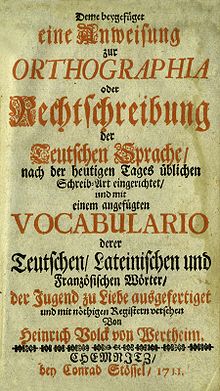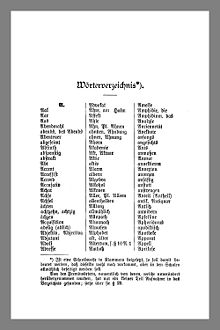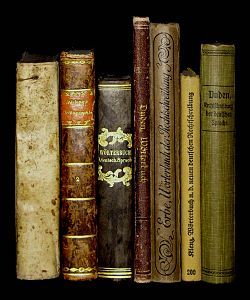Orthographic dictionary
An orthographic dictionary (also orthographic dictionary , spelling dictionary or dictionary of spelling ) belongs to the information-type- oriented dictionaries and in the narrowest sense only provides information on how a word is spelled. Often, however, individual or all words are provided with additional information or the entire dictionary is linked to a set of rules or textbooks from which the spelling of the words is derived.
designation
Whether a work is called an orthographic dictionary or has a different title with a reference to its orthographic usefulness is at the discretion of the author or editor, because ultimately it is possible to find out from every dictionary how the words in it are spelled. However , the less additional information is given than is required for the spelling of a word, the more likely it is to describe a dictionary as orthographic .
Demarcation
The orthographic dictionaries are on the one hand to be distinguished from other dictionaries and on the other hand from textbooks or rules of spelling that do not contain a dictionary. Even grammars that contain a dictionary in a chapter on spelling do not become an orthographic dictionary. Borderline cases are the official rules for spelling. They do contain orthographic dictionaries , but these lists are limited to a certain number of words and dubious cases and do not strive for completeness like a dictionary.
scope
The smallest works are less than 30 pages long. The largest orthographic dictionary “without additional information” was the Buchdruckerduden by Konrad Duden in the second edition from 1907, which had 393 four-column pages.
history
18th century
In 1711 an instruction on the ORTHOGRAPHIA or spelling of the German language appears / arranged according to today's usual writing style / and with an appended VOCABULARIO of the German / Latin and French words / the youth for love completed and provided with the necessary registers by Heinrich Volck von Wertheim . CHEMNITZ / bey Conrad Stössel / 1711. This work is an orthographic and a foreign dictionary. The orthographic part has 179 pages with 2 columns and there are almost no explanations beyond the spelling.
In 1722 Hieronymus Freyer's instructions on German orthography appear . The work has two parts: The instruction on German orthography, first part, to write correctly on the rule and guideline, and The instruction on German orthography, other part, on the use of the specified rule and guideline. The second part has 192 pages with seven chapters in one column of words in the notation developed in the first part with explanations.
In 1748, Johann Christoph Gottsched's Foundation of a German Art of Language appears . The title of the fifth main part in the first part reads Orthographic Directory of Certain Doubtful Words . The directory has 51 pages, is one column and gives explanations in Latin.
In 1764 Ignaz von Weitenauer's Orthographic Lexicon appears.
In 1788 Johann Christoph Adelung's small dictionary for pronunciation, orthography, inflection and derivation appears as the second part of the complete instruction on German orthography .
In 1796 Joseph Wismayr's Principles of the German Language appear . The second part is called the theory of orthography and has an appendix listing the most excellent identical or similar words in the High German language, with examples and comments on how they must be written in each case. The appendix has 98 pages, is one column and gives no explanations for the words, but short example sentences for each word, e.g. B. Bee - the bee collects honey .
19th century
In 1841 Johann Karl Christoph Vogel's school dictionary of the German language appears. With special regard to facilitating and promoting orthography. The book has 586 two-column pages.
From 1855, orthographic dictionaries for use in schools were published, in 1855 in Hanover, 1857 in Leipzig and 1870 in Berlin.
In 1861, the first official orthographic dictionary for use in schools appears in Württemberg .
In 1875 Daniel Sanders ' Orthographic Dictionary or alphabetical index of all German or German naturalized words with difficult or questionable spelling appears in final determination.
In 1879 an official orthographic dictionary appears in Austria .
From 1879, official orthographic dictionaries for use in schools were also published in Bavaria, Prussia and Baden.
In 1880 Konrad Dudens Complete Orthographic Dictionary of the German Language appeared and in 1881 his Orthographic Guide , an orthographic dictionary "for your pocket". In 1882 his Complete Orthographic Dictionary for Schools appeared.
20th century
In 1900 the sixth edition of Duden's Complete Orthographic Dictionary appeared .
From 1902, standardized orthographic dictionaries appear in the German federal states. Since then, the orthographic dictionaries have been based exclusively on the standardized rules and dictionaries.
In 1902 Karl Erbe's dictionary of German spelling appears .
In 1902 the 7th edition of Konrad Duden's dictionary was given the title Orthographic Dictionary of the German Language, and his Orthographic Dictionary was published in the Meyers Volksbuch series .
In 1903 Konrad Dudens spelling of the German language book printing works (" Buchdruckerduden ") appeared because the book printing associations of Germany, Austria and Switzerland complained about the large number of possible choices between spellings. The Buchdruckerduden therefore contains exactly one spelling for each word .
In 1903 Otto Garrazin published the dictionary for a German standard spelling.
In 1904 Heinrich Klenz's dictionary was published using the new German spelling .
In 1915 Konrad Duden's dictionary was given the title Duden , Spelling of the German Language and Foreign Words, as the 9th edition .
In 1927 the sixth and final edition of Karl Erbe's dictionary of German spelling appears .
In 1929 the 10th edition of the Duden appears under the title Der große Duden. Spelling of the German language and foreign words.
1930 Wilhelm Ede's dictionary of spelling appears .
In 1941, Hans Stanglmaier's A to Z dictionary and list of rules was published .
From 1942 onwards, all orthographic dictionaries, like all other printed works, appear in Antiqua (see Antiqua-Fraktur-Streit ).
Between 1946 and 1949, on the basis of private or trade union initiative, orthographic dictionaries were published in the Allied occupation zones , which were based on the official pre-war lists . Issues will continue after 1949.
In 1947 the first post-war edition of the Duden was published in Leipzig.
In 1955 the Duden was also published in Mannheim. In 1956, the Conference of Ministers of Education gave him the privilege of being binding on questions of doubt. From 1956 to 1996 the competing publishers of orthographic dictionaries struggled unsuccessfully against this privilege.
From 1996 all orthographic dictionaries have equal rights. Because of the differences between the dictionaries, the general discussion is particularly heated at this point.
present
There are currently a large number of competing orthographic dictionaries trying to increase their market share by adding a special presentation or additional information to each word. They sometimes differ in the spelling of the words because they are based on different spelling rules or interpret them differently. However, they can be divided into two categories: those who state that they adhere to the current set of rules (official rules) adopted by the Conference of Ministers of Education and Cultural Affairs , and those who do not. Only those spelling dictionaries that state that they adhere to the official rules are approved for use in schools.
Orthographic dictionaries (selection)
- Heinrich Volck von Wertheim: Instructions for ORTHOGRAPHIA or spelling of the German language. Chemnitz 1711.
- Hieronymus Freyer: Instructions for Teutschen Orthographie [page 219–413]. Hall 1722.
- Johann Christoph Gottsched: Foundation of a German art of language [Page 65–115] Leipzig 1748.
- Ignaz von Weitenauer: Orthographic Lexicon. Augsburg and Freiburg 1764.
- Johann Christoph Adelung: Small dictionary for pronunciation, orthography, bending and derivation as the second part of the complete instruction on German orthography . Leipzig 1788.
- Joseph Wismayr: Principles of the German language [page 177-276]. Salzburg 1796.
- Johann Karl Christoph Vogel: School dictionary of the German language. With special regard to facilitating and promoting orthography. Leipzig 1841.
- Daniel Sanders: Orthographic Dictionary. Leipzig 1875.
- Konrad Duden: Complete Orthographic Dictionary of the German Language. Leipzig 1880.
- Konrad Duden: Orthographic guide. Leipzig 1881.
- Konrad Duden: Complete orthographic dictionary for schools. Leipzig 1882.
- Konrad Duden: Orthographic dictionary of the German language. Leipzig 1902
- Karl Erbe: Dictionary of German Spelling . Stuttgart, Berlin, Leipzig 1902.
- Konrad Duden: Orthographic dictionary. Leipzig undated [1902]
- August Vogel: Comprehensive grammatical and orthographic reference book for the German language including the more common foreign words, details of the more difficult hyphenation and punctuation rules. For everyday use for everyone. According to the latest orthography from 1902. Berlin 1903.
- Konrad Duden: Spelling of the German language book printers. Leipzig 1903.
- Heinrich Klenz: Dictionary based on the new German spelling. Leipzig 1904.
- J. Ernst Wülfing, Alfred C. Schmidt: Duden, spelling of the German language and foreign words. Leipzig 1915.
- Theodor Matthias: The great Duden. Spelling of the German language and foreign words. Leipzig 1929.
- Wilhelm Ede: Dictionary of Spelling. Elberfeld 1930.
- Georg Wolff: Dictionary to look up spelling, linguistic and verbal knowledge. Langensalza undated [approx. 1930].
- Hans Stanglmaier: A to Z dictionary and index of rules . Munich and Berlin 1941.
- Committee of the trade union for teachers and educators in the FDGB: Rules for German spelling, including a dictionary and examples of punctuation. Berlin and Leipzig 1946.
- Horst Klien: Duden. Spelling of the German language and foreign words. Leipzig 1947.
- Committee of the union of teachers and educators in the FDGB: German spelling. Rules and dictionary. Berlin and Leipzig 1948.
- Otto Basler: German spelling. Rules and dictionary. Munich 1948.
- Wilhelm Schradi: Rules for German spelling [with orthographic vocabulary]. Stuttgart 1949.
- Lutz Mackensen: German spelling . Gütersloh 1954.
- Arthur Busse: Langenscheidt's German Dictionary. Spelling and Grammar. Berlin 1955.
- Dudenredaktion: Duden spelling of the German language and foreign words. Wiesbaden 1955.
- German spelling. Rules and dictionary. Official regulation. Düsseldorf 1996, ISBN 3-931795-06-3 .
- Serges Medien GmbH: Dictionary of Spelling . Cologne 1999.
- Duden editorial office: Duden. The German spelling. The comprehensive standard work based on the new official spelling rules. Bibliographisches Institut & FA Brockhaus AG, Mannheim [u. a.] 2006, ISBN 3-411-04014-9 .
- WAHRIG German spelling with CD-ROM. Gütersloh and Munich 2008, ISBN 978-3-577-07570-1 .
- For Austria: Austrian dictionary
literature
- Wilhelm Wilmanns: The orthography in schools in Germany. Commentary on the Prussian school orthography. Weidmannsche Buchhandlung, Berlin 1880 (second revised edition, ibid. 1887; its reprint: Olms, Hildesheim 2005, ISBN 3-487-12807-1 ).
- Julius Jakob: Orthographic auxiliary book for Austrian book printers when used by Privy Councilor Dr. Konrad Dudens spelling of the German language printing works . Vienna 1907.
- KE Rotzler: Duden's writing and language stupidities. - The "Grosse Duden" under the Swiss magnifying glass - Contributions for reliable spelling. Bern 1947.
- Burckhard Garbe (ed.): The German orthography and its reform 1722–1974. Collection of articles and book excerpts on the history of German spelling. Niemeyer, Tübingen 1978, ISBN 3-484-10294-2 .
- Eva-Maria Heinle: Hieronymus Freyer's instruction on German orthography . Heidelberg 1982, ISBN 3-533-03228-0 kart. ISBN 3-533-03229-9 Ln.
- Wolfgang Werner Sauer: The "Duden". History and topicality of a “folk dictionary” . J. B. Metzlersche Verlagsbuchhandlung, Stuttgart 1988, ISBN 3-476-00638-7 .






